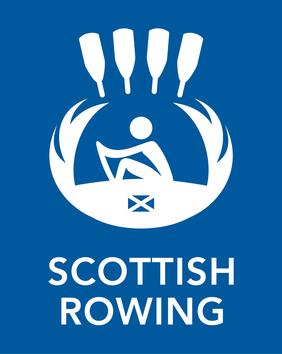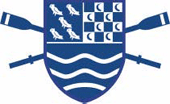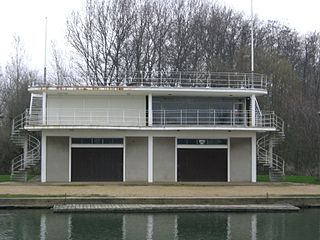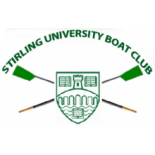
The Union Canal, full name the Edinburgh and Glasgow Union Canal, is a canal in Scotland, running from Falkirk to Edinburgh, constructed to bring minerals, especially coal, to the capital. It was opened in 1822 and was initially successful, but the construction of railways, particularly the Edinburgh and Glasgow Railway, which opened in 1842, diminished its value as a transport medium. It fell into slow commercial decline and was closed to commercial traffic in 1933. It was officially closed in 1965. The canal is listed as three individual scheduled monuments by Historic Scotland according to the three former counties, Midlothian, West Lothian and Stirlingshire, through which it flows.

The Championship Course is a stretch of the River Thames between Mortlake and Putney in London, England. It is a well-established course for rowing races, particularly the Oxford and Cambridge Boat Race. The course is on the tidal reaches of the river often referred to as the Tideway. Due to the iconic shape of the Championship Course, in orthopaedic surgery, an "S" shaped incision along the crease of the elbow is commonly referred to as "a boat-race incision resembling the River Thames from Putney to Mortlake."

Vesta Rowing Club is a rowing club based on the Tideway of the River Thames in Putney, London, England. It was founded in 1870.

Scottish Rowing (SR), formerly the Scottish Amateur Rowing Association, is the governing body for the sport of rowing in Scotland. It is responsible for promoting the sport in Scotland and also for selecting crews to send to the Home International Regatta and the Commonwealth Rowing Championships. In addition, Scottish Rowing also runs three of the major regattas of the year, Strathclyde Park Regatta, the Scottish Rowing Championships and the Scottish Indoor Rowing Championships.

Glasgow University Boat Club (GUBC) is the rowing club of the University of Glasgow, Scotland. The club is affiliated to Scottish Rowing.

Coastal and offshore rowing is a rowing sport performed at sea. In North America, this sport is often called open water rowing.

Harry Clasper was a professional rower and boat builder from Tyneside in England. He was an innovative boat designer who pioneered the development of the racing shell and the use of outriggers. He is said to have invented spoon-shaped oars.

In a rowing crew, the coxswain is the member who does not row but steers the boat and faces forward, towards the bow. The coxswain is responsible for steering the boat and coordinating the power and rhythm of the rowers. In some capacities, the coxswain is responsible for implementing the training regimen or race plan. Most coaches cannot communicate to boat/coxswain, so the coxswain is the "coach" in the boat. A coxswain is necessary in the first place because the rowers sit with their backs to the direction of travel.

Durham University Boat Club (DUBC) is the rowing club of Durham University. In recent years, DUBC has cemented itself as one of the strongest university boat clubs in Great Britain. Under the leadership of former British Olympian Wade Hall-Craggs, DUBC notably won the BUCS Victor Ludorum for ten consecutive years (2004-2013), and has produced a number of athletes that have competed internationally at European and World Championship level.

The Victorian Head of the River regatta is contested between the eleven Associated Public Schools of Victoria (APS).

Putney Town Rowing Club (PTRC) is a rowing club on the Tideway, the tidal reach of the River Thames in England. Its official British Rowing registered colours are navy and white.

Edinburgh University Boat Club (EUBC) is one of the oldest sports clubs of the University of Edinburgh, in the city of Edinburgh, Scotland.

Lancaster University Boat Club (LUBC) is the rowing club of Lancaster University. The club was founded in 1964 with the inception of the university by Sir Harold Parkinson and is the oldest sports club at the university. The club is based in the old Halton railway station and trains on a 3 km stretch of the River Lune, 3 miles north of Lancaster.

Keble College Boat Club (KCBC) is the rowing club of Keble College, in Oxford, United Kingdom. The boat club is based in its boathouse on the Isis, which is shared with Jesus College. Most of the year is spent training at the boat club's second facility at the Godstow stretch to the North.

Clydesdale Amateur Rowing Club is Scotland's largest rowing club, located on the River Clyde in the centre of Glasgow. It is successful each year in many events at the Scottish Rowing Championships and is affiliated to Scottish Rowing.

Stirling University Boat Club is one of the sports clubs who are part of University of Stirling, in the city of Stirling, Scotland.

St Andrew Boat Club is alongside Meggetland Sports Complex, at Meggetland, on the Union Canal, in the city of Edinburgh, Scotland.

The University of St Andrews Boat Club (UStABC), founded in 1962, is the rowing team affiliated to the University of St Andrews. Operating under the University of St Andrews Athletic Union, the club competes in head races and regattas across Scotland and England, including the Head of the River Race (London), British Universities and Colleges Sport (BUCS) Regatta and Henley Royal Regatta. Its national governing body is Scottish Rowing and the registration code of 'SAU'.
The Boat Race 2020 was a side-by-side rowing race scheduled to take place on 29 March 2020. Held annually, The Boat Race is contested between crews from the universities of Oxford and Cambridge along a 4.2-mile (6.8 km) tidal stretch of the River Thames in south-west London. This would have been the 75th women's race and the 166th men's race, and for the fifth time in the history of the event, the men's, women's and both reserves' races would have been held on the Tideway on the same day. Cambridge led the longstanding rivalry 84–80 and 44–30 in the men's and women's races, respectively.

The Boat Race 2022 was a side-by-side rowing race which took place on 3 April 2022. Held annually, The Boat Race is contested between crews from the universities of Oxford and Cambridge, usually along a 4.2-mile (6.8 km) tidal stretch of the River Thames, known as the Tideway, in south-west London. This was the 76th women's race and the 167th men's race. Cambridge led the longstanding rivalry 85–80 and 45–30 in the men's and women's races, respectively. The race returned to the Tideway after the previous year's race had taken place without spectators, on the River Great Ouse. This followed the cancellation of the 2020 race as a response to the COVID-19 pandemic in the United Kingdom.





















